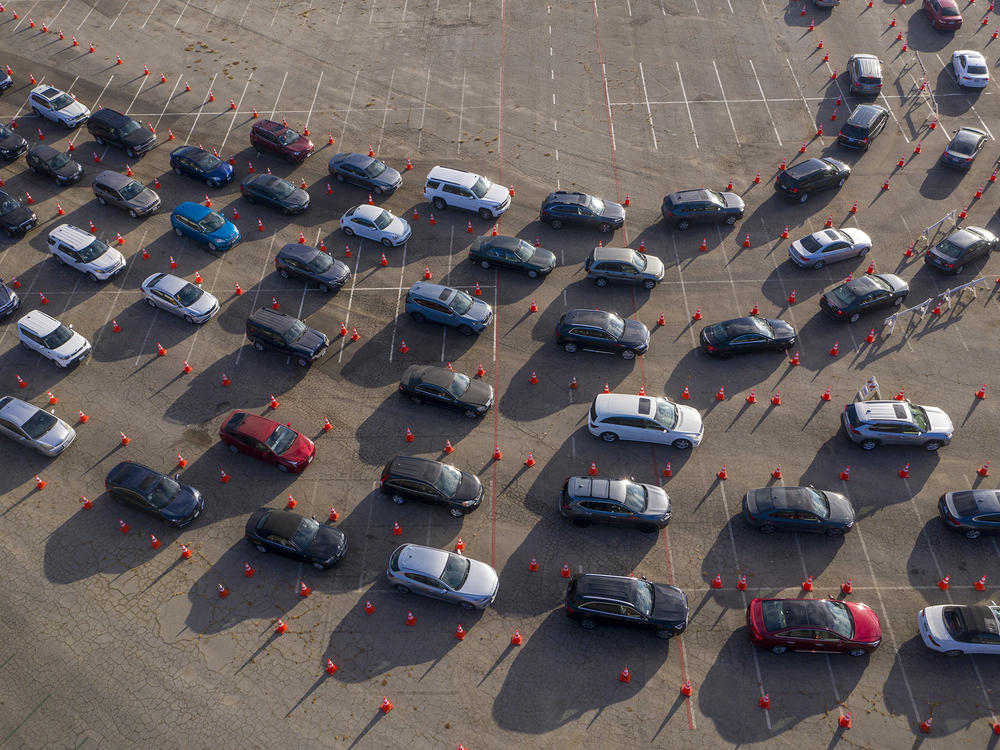Section Branding
Header Content
A Rush On Coronavirus Testing Strains Laboratories, Drives Supply Shortages
Primary Content
With the pandemic out of control in the United States, the nation's precarious coronavirus testing system is starting to strain again.
Long lines are again forming in some places as the surge of infections drives a surge in demand for testing. Testing companies, lab directors and testing policy experts warn that waiting times for results could soon start to lengthen. In fact, one of the largest commercial testing companies Tuesday reported turnaround times had already started creeping up.
"We're still far behind where we need to be with testing. And as these cases skyrocket, the need for tests are far outpacing what we have," says Heather Pierce, senior director for science policy and regulatory counsel at the Association of American Medical Colleges.
Testing shortages have hobbled the nation's ability to fight the pandemic since it began. But testing improved significantly since the spring, when tests were scarce and waiting times were often long. Tests are now accessible at many locations, including doctors' offices, clinics, fire stations, drive-through test sites, and grocery and drug stores. People can even drop a sample of spit into the mail to find out if they're infected.
More than 167 million tests have been conducted in the U.S. and more than 1.4 million tests were done daily on average in November, according to data gathered by The Covid Tracking Project. That's up from just over 800,000 on average per day in September.
But even the current level of testing is far less than what many experts say is needed. And even though people can sometimes get their results within minutes, many still have to wait at least two days or more, which is still too long to make sure they don't spread the virus to other people. The lack of enough quick testing is probably one of the reasons driving the surge, experts say.
"We have come a long way," says Mara Aspinall, a professor of biomedical diagnostics at Arizona State University. "But testing is not broadly available everywhere in the country.
Despite the federal government's continued efforts to ship millions of swabs and vials and other testing supplies to states, half of labs are reporting shortages of test kits and two-thirds are reporting shortages of crucial chemicals and other supplies, such as like plastic tips for devices called pipettes. So labs still scramble every day, lab directors report. And they say the shortages are intensifying, especially for pipette tips and some test kits.
"I feel like we're moving chairs around on the Titanic. We're trying to, you know, move things around to make things work and get everything in order. But we're on this big ship that's sinking," says Melissa Miller, who runs the testing lab at the University of North Carolina, Chapel Hill.
Some labs are now also running short on staff because they're getting infected and sick themselves.
"A lot of people are out either because they're being quarantined because of a potential exposure to someone with confirmed COVID or they themselves have COVID-19," says Dr. Bobbi Pritt, who chairs the clinical microbiology committee for the College of American Pathologists and runs the division of clinical microbiology at the Mayo Clinic. "I would say that's our biggest concern right now."
And the testing situation could easily get worse. The flu season hasn't even hit hard yet, which will strain labs even more. And demand for tests will likely surge more as more people rush to to get tested so they can see family for the holidays.
"If this pandemic continues and and blows off the top of this, I can't tell you for certain that in a couple of weeks doomsday's not here for laboratory capacity," says Bill Whitmar, who runs the state lab in Missouri and serves as president of the Association of Public Health Laboratories.
Trump administration officials say that in addition to rushing supplies to labs, the federal government has been doing everything it can to shore up testing. The government has opened special surge testing sites in at least 10 states and is shipping tens of millions of rapid tests to nursing homes and for use by schools, first responders and others, according to Adm. Brett Giroir, who's in charge of testing at the Health and Human Services Department.
"We're aggressively helping states in in any way that we that we can," Giroir told reporters Monday during a briefing.
Copyright 2020 NPR. To see more, visit https://www.npr.org.

